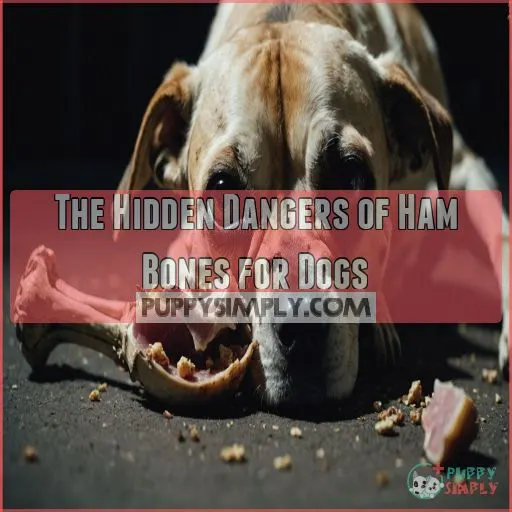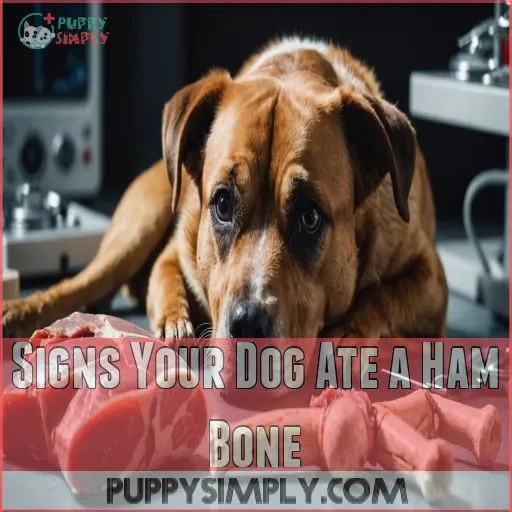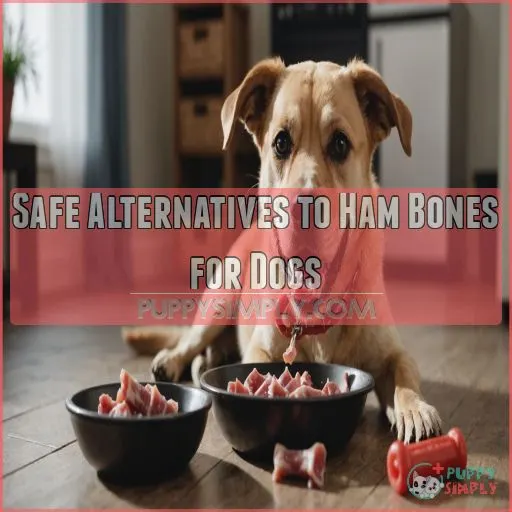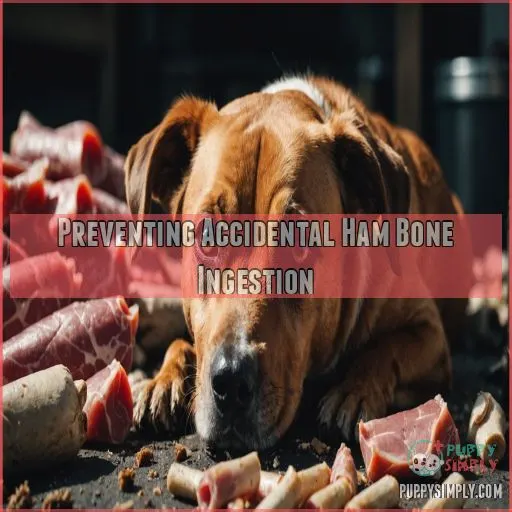This site is supported by our readers. We may earn a commission, at no cost to you, if you purchase through links.
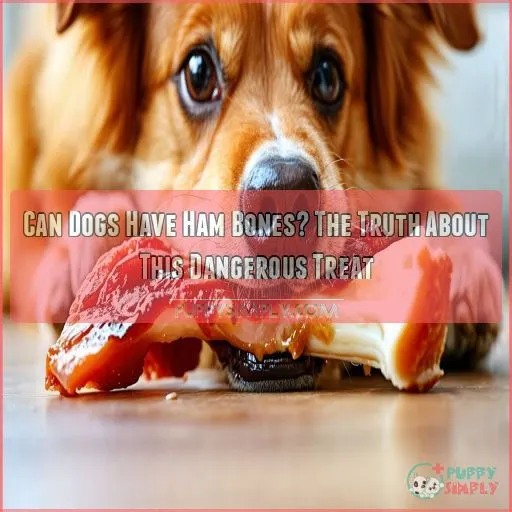
Ham bones can splinter easily, potentially causing choking, blockages, or internal injuries.
Your furry friend could end up with a fractured tooth or even a perforated intestine.
It’s not worth the risk, no matter how much those puppy eyes beg.
If your dog accidentally gets hold of a ham bone, watch for signs like vomiting, lethargy, or bloody stools.
Contact your vet immediately if you notice anything off.
If you’re considering giving your dog bones, it’s essential to know that even raw bones require supervision. Don’t worry, though – there are plenty of safe alternatives to satisfy your dog’s chewing instincts.
Stick around to discover some tasty and tooth-friendly options.
Table Of Contents
- Key Takeaways
- The Hidden Dangers of Ham Bones for Dogs
- Signs Your Dog Ate a Ham Bone
- Immediate Actions if Your Dog Eats Ham Bones
- Safe Alternatives to Ham Bones for Dogs
- The Truth About Ham in Your Dog’s Diet
- Creating a Balanced Diet for Your Dog
- Preventing Accidental Ham Bone Ingestion
- Frequently Asked Questions (FAQs)
- Conclusion
Key Takeaways
- Ham bones are extremely dangerous for dogs; they splinter easily, causing choking, internal injuries, and dental problems. Don’t risk it.
- If your dog eats a ham bone, it’s likely because they’re attracted to the salty flavor and high fat content found in processed meats like ham, watch for vomiting, lethargy, bloody stools, or difficulty breathing. Contact your vet immediately if you see any of these signs.
- Plenty of safe alternatives exist to satisfy your dog’s chewing needs, including raw bones (appropriate sizes), commercial chew toys, and dental chews. Explore these options.
- While small amounts of ham meat might be okay occasionally, it’s high in sodium and isn’t a good nutritional choice. Focus on a balanced diet for your dog’s overall health.
The Hidden Dangers of Ham Bones for Dogs
You might think ham bones are a tasty treat for your furry friend, but they can be surprisingly dangerous.
These seemingly innocent chews can splinter easily, potentially causing serious internal injuries or painful dental problems for your dog.
Risks of Cooked Bones
Fido’s favorite treat might be a ticking time bomb.
Cooked bones, especially ham bones, can splinter into sharp shards when your dog chews them.
Unlike raw bones, cooking leaches nutrients and collagen, leaving them brittle and dangerous.
These bone splinters can become lodged in your pup’s throat, causing choking hazards or esophageal blockages (Source).
Don’t let your furry friend become a statistic – steer clear of cooked bones and opt for safer alternatives.
Potential Internal Injuries
Your furry friend’s digestive journey can turn treacherous with ham bones.
These seemingly innocent treats can wreak havoc inside, causing:
- Esophageal damage from sharp edges scraping delicate tissues
- Intestinal blockages as bone fragments get stuck
- Rectal perforation when jagged pieces pass through
- Internal bleeding from punctures along the digestive tract
Don’t let your pup’s curiosity lead to a vet emergency. Stick to safe chews and keep those ham bones out of reach. Your dog’s wagging tail will thank you!
Dental and Oral Hazards
Beyond internal injuries, ham bones pose serious dental and oral hazards for your furry friend.
These seemingly innocent treats can lead to tooth fractures, gum infections, and jaw damage (Source).
Bone splinters might cause mouth bleeding, turning a tasty moment into a painful ordeal.
It’s like giving your pup a ticking time bomb disguised as a treat.
Instead, consider safer alternatives like rawhide or specialized dog chews to keep those pearly whites intact and healthy.
Signs Your Dog Ate a Ham Bone
You’ll want to be on high alert if you suspect your dog has eaten a ham bone.
Watch for signs like vomiting, lethargy, or bloody stools, which could indicate serious internal injuries.
Digestive Distress Symptoms
Dogs can be sneaky when it comes to snagging forbidden treats.
Watch for vomiting, diarrhea (possibly bloody), or constipation as telltale signs of ham bone ingestion.
Bloating and abdominal pain might manifest as a hunched posture or yelping when touched.
Keep an eye on your pup’s appetite and weight; sudden changes could indicate digestive distress.
If you notice these symptoms, don’t wait – contact your vet immediately for proper care of your furry friend’s gastrointestinal tract.
Behavioral Changes to Watch For
Several behavioral changes can indicate your furry friend has eaten a ham bone.
Keep an eye out for unusual lethargy or restlessness, as if your pup can’t get comfortable.
They might lose their appetite or start vomiting.
Some dogs hide when they’re not feeling well, so check their favorite spots.
These signs could mean it’s time to call the vet and discuss pet insurance options for your canine companion’s health.
Emergency Warning Signs
While behavioral changes can be subtle, emergency warning signs demand immediate action.
You’ll need to keep a watchful eye for these red flags:
- Vomiting or bloody stools
- Extreme lethargy or lack of appetite
- Difficulty breathing or excessive drooling
These symptoms could indicate your furry friend’s in hot water after chomping on a ham bone.
Don’t play the waiting game – if you spot these signs, it’s time to hustle to the vet. Your quick action could be a real lifesaver!
Immediate Actions if Your Dog Eats Ham Bones
If your dog has eaten ham bones, swift action is necessary to prevent potential complications.
Contact your veterinarian immediately and monitor your pet closely for signs of distress.
Provide as much information as possible about the incident to guarantee prompt and appropriate care.
Contacting Your Veterinarian
If you’ve spotted signs of ham bone ingestion, it’s time to take action.
Call your vet immediately.
Don’t wait for symptoms to worsen – quick action can be a lifesaver.
Be aware that cooked bones, like ham bones, can cause Internal Injuries.
Here’s what to do:
| Action | Why | How |
|---|---|---|
| Call vet | Urgent care | Describe situation |
| Prepare info | Aids diagnosis | Note amount eaten |
| Discuss options | Treatment plan | Follow vet’s advice |
| Stay calm | Better communication | Take deep breaths |
Remember, you’re your pup’s first line of defense.
Stay cool as a cucumber and get that expert help pronto!
Monitoring Your Dog’s Condition
Once you’ve called the vet, keep a hawk’s eye on your furry friend.
Watch for any unusual dog behavior changes, like lethargy or excessive drooling.
Monitor their appetite changes and activity level closely.
Check their stool consistency for any signs of blood or unusual color.
Note the frequency of vomiting, if any occurs.
These observations will be very important for your vet to assess the situation and provide the best care possible.
Providing Relevant Information to The Vet
Your dog’s been naughty with ham bones? Time to play detective.
Give your vet the full scoop: bone size, ham quantity, dog’s breed and age, and time elapsed since ingestion.
This info’s golden for tailoring treatment.
Don’t sugarcoat it; be honest about any pre-existing conditions or medications.
Remember, you’re partners in your pup’s health.
Every detail counts in keeping your furry friend safe and sound.
Safe Alternatives to Ham Bones for Dogs
You don’t have to deprive your furry friend of chewing pleasure just because ham bones are off-limits.
There are plenty of safe alternatives that’ll keep your dog’s tail wagging, from appropriate raw bones to specially designed chew toys that clean teeth and satisfy that gnawing instinct.
Appropriate Raw Bones
Raw bones can be a safer alternative to ham bones for your furry friend.
Opt for edible bones like chicken necks, feet, or pork tails.
These provide mental stimulation and dental benefits while satisfying your dog’s natural urge to chew.
When selecting bones, be sure to avoid any with preservatives like nitrates and nitrites, which can be harmful for dogs.
Remember, size matters – choose bones appropriate for your dog’s breed and chewing habits .
Treat raw bones like raw meat, storing them properly in the fridge to prevent spoilage.
Your pup will thank you with a wagging tail!
Commercial Chew Toys
While ham bones are off the table, commercial chew toys offer safe alternatives for your pup’s gnawing needs.
These toys are designed with safety and durability in mind, giving you peace of mind while your furry friend satisfies their natural urge to chew.
When choosing a chew toy, look for:
- Bendable materials that won’t splinter
- Toys that pass the "kneecap test"
- Reputable brands like Tuffie Toys and Kong
Remember, supervision is key to make sure your dog’s chewing remains safe and enjoyable.
Dental-Friendly Treats
Looking for a treat that’s both tasty and tooth-friendly?
Ditch those risky ham bones and opt for VOHC-approved dental chews .
These clever alternatives, like Greenies or Purina DentaLife, work double-duty by freshening breath and reducing tartar.
For a DIY twist, try flat, softer rawhide chews – they’re safe and effective plaque-busters.
Remember, though, always keep an eye on your pup while they’re enjoying their dental delights.
The Truth About Ham in Your Dog’s Diet
You might think a slice of ham is a harmless treat for your furry friend, but the truth about ham in your dog’s diet isn’t so simple.
While dogs can eat small amounts of ham occasionally, it’s important to understand the potential risks and nutritional implications before sharing this popular protein with your canine companion.
Nutritional Value of Ham
Now that we’ve explored safer chew options, let’s talk turkey about ham – or rather, let’s ham it up!
Ham packs a protein punch, with about 14 grams per 3-ounce serving.
It’s relatively low in fat, containing only 4 grams per serving.
However, ham’s sodium levels can be sky-high, with up to 1050mg per serving.
For your furry friend, ham’s digestibility isn’t top-dog, and there are better protein alternatives designed specifically for canine nutrition.
Potential Health Risks
The siren song of ham bones can lead your furry friend into treacherous waters.
Consider these potential health risks:
- Bone splintering: Cooked ham bones are brittle and can splinter, causing mouth or internal injuries.
- Choking hazards: Large bone pieces may become lodged in your dog’s throat.
- Digestive distress: Bone fragments can trigger vomiting, diarrhea, or even intestinal blockages.
Don’t let your pup’s puppy-dog eyes fool you—these risks aren’t worth the temporary tail wag.
Moderation and Portion Control
Many dog owners wonder about ham as a treat, but moderation is key.
You’ll want to keep portions small and infrequent.
Let’s break down the facts:
| Consideration | Guideline |
|---|---|
| Treats | Max 10% of daily calories |
| Ham portion | Thumbnail-sized, occasionally |
| Weight management | Monitor closely |
| Feeding schedule | Stick to regular meals |
| Alternatives | Low-fat dog food brands |
Remember, your pup’s health comes first. Treat wisely, and you’ll both be wagging tails (Source).
Creating a Balanced Diet for Your Dog
You’ll need to balance essential nutrients to keep your furry friend healthy and happy.
Commercial dog food offers convenience.
Tailoring your dog’s diet to their age and health needs can provide the best nutrition.
Essential Nutrients for Dogs
While ham mightn’t be ideal, your furry friend needs a balanced diet to thrive.
Dogs require six key nutrients: proteins, fats, carbohydrates, vitamins, minerals, and water.
Protein builds tissues, while fats provide energy and keep skin healthy.
Don’t forget carbs for powering tissues and maintaining intestinal health.
Vitamins and minerals support various bodily functions, from bone strength to chemical reactions.
It’s like cooking a gourmet meal for your four-legged chef!
Commercial Vs. Homemade Dog Food
Now that you know the essential nutrients, creating a balanced diet for your dog is important, and a beagle homemade dog food recipe can be a great option with its numerous benefits, including improved overall health and nutrition by providing fresh ingredients free from added hormones and artificial additives Beagle Homemade Dog Food.
Commercial options offer convenience and balanced nutrition, but homemade meals give you control over ingredients and quality.
It’s like choosing between fast food and home cooking for your pup.
Consider your budget, time, and Fido’s needs.
Remember, whichever path you choose, your dog’s tail should wag with delight at mealtime!
Tailoring Diet to Age and Health
Your dog’s diet should be as unique as they are.
Puppies need more calories and protein for growth, while seniors benefit from joint-supporting nutrients.
If your furry friend’s carrying a few extra pounds, consider a diet lower in fat but high in fiber.
Got a pooch with food allergies? You might need to whip up some homemade meals to keep their tails wagging and tummies happy.
Preventing Accidental Ham Bone Ingestion
You’re not just protecting your dog’s health, but also your peace of mind when you take steps to prevent accidental ham bone ingestion.
By implementing proper food disposal techniques, training your dog, and securing trash and leftovers, you’ll create a safer environment for your furry friend.
Proper Food Disposal
Proper food disposal is key to keeping your furry friend safe from ham bone accidents.
Think of your kitchen as a fortress against canine curiosity.
Use dog-proof containers for leftovers and secure those trash cans like they’re guarding Fort Knox.
Don’t let those scraps linger – out of sight, out of mind (and mouth)!
Remember, a clean kitchen isn’t just for show; it’s your first line of defense in pet safety.
Training Your Dog
Training your dog is key to preventing ham bone mishaps.
Start early with basic obedience commands .
Here’s a quick guide to keep your furry friend safe:
- Teach "leave it" and "drop it" commands
- Practice "come" for reliable recall
- Use positive reinforcement with treats and praise
- Establish a consistent routine
Remember, a well-trained pup is a safer pup.
With patience and practice, you’ll have a canine companion who’s less likely to snatch dangerous treats.
Securing Trash and Leftovers
A savvy dog-owner knows that a dog-proof kitchen is key to preventing ham bone mishaps.
Lock up those trash cans tight – it’s not just kid-proof trash you need, but Fido-proof too!
Secure storage is your best friend here.
Keep leftovers out of reach, and use airtight containers for food storage.
Remember, a curious nose can lead to trouble, so stay one step ahead of your four-legged Houdini.
Frequently Asked Questions (FAQs)
Are ham bones dangerous for dogs?
Just as a bone can snap unexpectedly, ham bones pose hidden dangers for your furry friend.
They’re a ticking time bomb of splintering hazards, choking risks, and potential blockages.
Stick to safer treats to keep your pup’s tail wagging.
Can dogs eat ham?
You’ll want to think twice before giving your dog ham.
While not toxic, it’s high in sodium and fat, which can lead to health issues like obesity and pancreatitis.
Save it for your sandwich instead.
Can dogs eat cooked bones?
Cooked bones are off-limits for your furry friend.
They splinter easily, posing serious risks like choking, internal injuries, and blockages.
Stick to safe alternatives like raw bones or dental chews to keep your pup’s chompers happy and healthy.
Are ham bones good for dogs?
Picture your pup gnawing on a ham bone – tempting, but risky.
Ham bones aren’t good for dogs.
They can splinter, causing mouth injuries or digestive blockages.
Stick to safer, dog-friendly treats to keep your furry friend happy and healthy.
Are raw ham bones safe for dogs?
Raw ham bones aren’t safe for your furry friend.
They’re a breeding ground for harmful bacteria and can easily splinter, posing serious health risks.
Stick to dog-specific chews to keep your pup happy and healthy.
How often can dogs chew on bones?
Bountiful bones bring benefits, but balance is key.
You’ll want to limit chewing sessions to 10-15 minutes daily.
For puppies, stick to soft chews, while adults can handle harder options.
Always supervise and choose size-appropriate bones for safety’s sake.
Can puppies have ham bones?
No, puppies shouldn’t have ham bones.
They’re a choking hazard and can splinter, causing serious harm.
Cooked bones are especially dangerous, as they’re softer and more likely to break.
Stick to puppy-safe chew toys instead.
What size bones are best for dogs?
Size matters when it comes to bones for your furry friend.
You’ll want to choose a bone that’s equal to or larger than your dog’s head.
This makes sure they can’t swallow it whole, keeping them safe while they chew.
Are store-bought ham bone treats different from real bones?
Store-bought ham bone treats differ greatly from real bones.
They’re processed and packaged specifically as dog treats, but they’ve been linked to serious health issues.
The FDA has received reports of illnesses and even deaths related to these commercial bone treats .
Conclusion
Did you know that 27% of dogs who eat cooked bones end up needing emergency vet care?
It’s clear that the answer to "can dogs have ham bones" is a resounding no.
Your pup’s health isn’t worth the risk.
Instead, opt for safe alternatives like dental chews or specially designed toys.
Remember, a well-balanced diet and appropriate treats are key to keeping your furry friend happy and healthy.
By making informed choices, you’re ensuring your dog’s tail keeps wagging for years to come.

